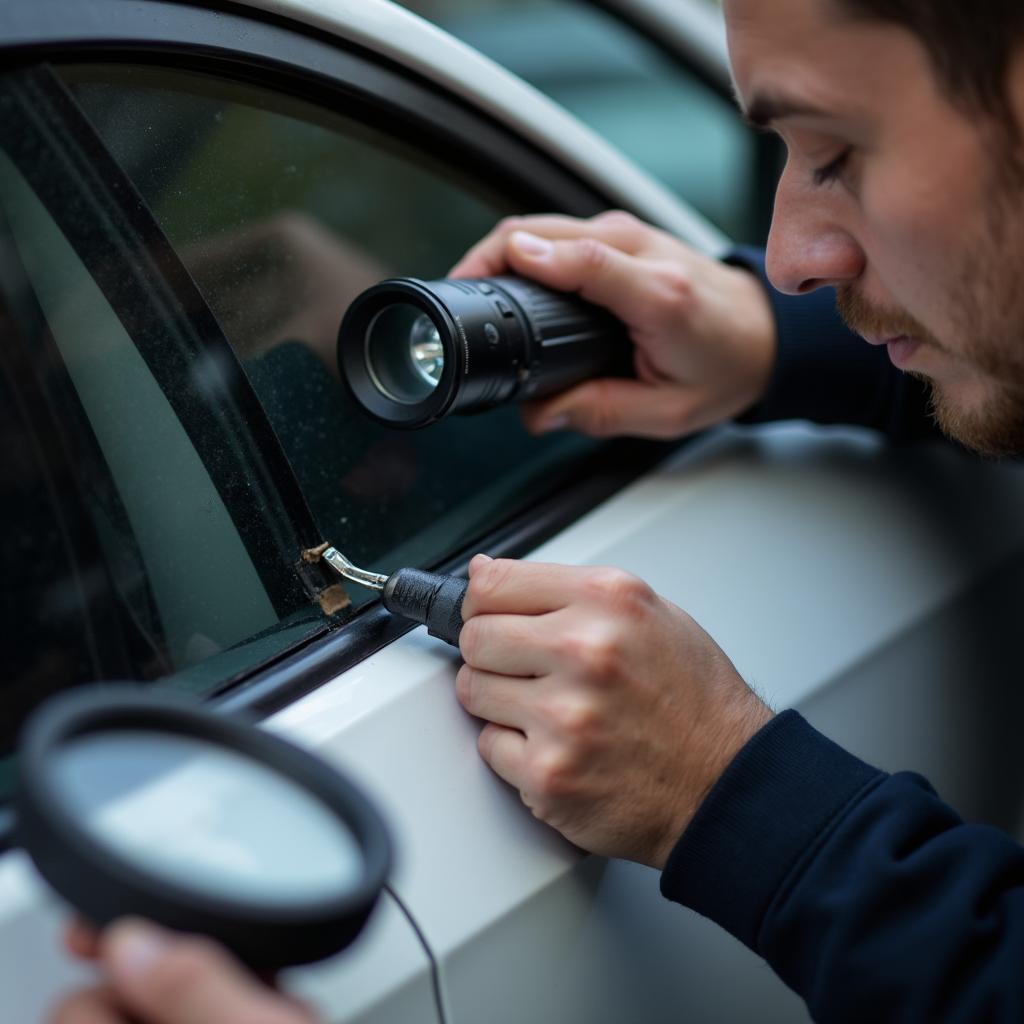Discovering a car window leak can be a frustrating experience. Not only is it annoying to deal with water intrusion, but it can also lead to potential damage to your car’s interior and electrical components. Fortunately, identifying and fixing a car window leak is often a manageable DIY project. This comprehensive guide will walk you through the steps on how to repair a car window leak and prevent it from happening again.
Common Causes of Car Window Leaks
Before diving into the repair process, it’s essential to identify the source of the leak. Here are some common culprits:
- Worn-out window seals: Over time, the rubber seals around your car windows can dry out, crack, or become brittle, creating gaps that allow water to seep through.
- Damaged window sweeps: Window sweeps are the rubber strips located on the inside of the door panel. If they become damaged or detached, they won’t effectively channel water away, leading to leaks.
- Clogged drain holes: Your car doors have small drainage holes designed to allow water to escape. If these holes become clogged with dirt, leaves, or debris, water can back up and enter the cabin.
- Loose or damaged window regulator: The window regulator is the mechanism that raises and lowers your car window. If it’s loose or damaged, it can create gaps in the window sealing, leading to leaks.
- Rust or corrosion: Rust and corrosion can eat away at the metal around your car windows, compromising the seal and causing leaks.
Materials You’ll Need for Car Window Leak Repair
Gather the following materials before you begin the repair:
- Cleaning supplies: A bucket of warm soapy water, a sponge or microfiber cloth, and a shop vacuum with a crevice attachment.
- Replacement weatherstripping or sealant: Depending on the source of the leak, you’ll need either replacement weatherstripping or a high-quality automotive sealant.
- Tools: Screwdrivers (Phillips and flathead), pliers, trim removal tools (optional), and a utility knife.
Step-by-Step Guide to Repairing a Car Window Leak
Follow these steps to repair your car window leak effectively:
- Locate the source of the leak: Thoroughly inspect the window seals, sweeps, and drain holes. Pour water over the window to help pinpoint the leak’s location.
- Clean the area: Use soapy water and a sponge or cloth to clean the area around the leak. This will help the sealant or weatherstripping adhere properly.
- Repair or replace the damaged component:
- For worn-out seals: Carefully remove the old seal using a trim removal tool or a flathead screwdriver. Clean the channel where the seal sits, apply a thin bead of automotive sealant to the channel, and firmly press the new seal into place.
- For damaged sweeps: Remove the door panel to access the window sweep. If the damage is minimal, you can try repairing it with sealant. For significant damage, replace the sweep entirely.
- For clogged drain holes: Use a straightened wire hanger or compressed air to clear any debris from the drain holes.
- For loose or damaged window regulators: This repair is best left to a professional mechanic.
- Test your repair: After the sealant has dried or the new component is installed, spray water over the repaired area to ensure the leak is fixed.
Tips to Prevent Future Car Window Leaks
- Regularly inspect your car’s window seals and sweeps for signs of wear and tear.
- Keep your car’s door drain holes clear of debris.
- Apply a rubber protectant to your window seals and weatherstripping every few months to prevent drying and cracking.
- Address any rust or corrosion around your car windows promptly.
When to Seek Professional Help
While many car window leaks can be addressed with DIY solutions, some situations warrant the expertise of a professional mechanic. Consider seeking professional help if:
- You’re uncomfortable working with automotive sealants or disassembling car door panels.
- The leak persists after attempting DIY repairs.
- You suspect the leak is due to a damaged window regulator or significant rust damage.
Conclusion
Addressing a car window leak promptly is essential for preventing water damage to your vehicle’s interior and electrical system. By following the steps outlined in this guide and adhering to preventative measures, you can keep your car dry, comfortable, and free of unwanted leaks. Remember, regular maintenance and early detection are key to keeping your car in optimal condition.
FAQs About Car Window Leaks
Q: How much does it cost to fix a car window leak?
A: The cost to repair a car window leak can range from a few dollars for DIY fixes to a few hundred dollars for professional repairs, depending on the severity of the leak and the components that need replacement.
Q: Can I drive my car with a window leak?
A: It’s best to address a car window leak as soon as possible. Driving with a leak can lead to water damage to your car’s interior, mold growth, and potential electrical issues.
Q: How long do car window seals last?
A: Car window seals typically last around 5-7 years, but their lifespan can vary depending on factors such as climate, exposure to the elements, and regular maintenance.
Q: Can I use silicone sealant to fix a car window leak?
A: While silicone sealant might seem like a quick fix, it’s not recommended for car window leaks. Automotive sealant is specifically designed to bond with automotive materials and withstand the harsh conditions that car windows are exposed to.
Q: What happens if water gets in my car door?
A: Water trapped inside your car door can cause rust and corrosion, damage to electrical components, and promote mold and mildew growth.
For more information on car window repairs, you can check out these helpful resources:
If you’re unsure about any aspect of repairing a car window leak, don’t hesitate to contact a qualified mechanic for assistance.
For any assistance, please contact us via WhatsApp: +1(641)206-8880, Email: [email protected]. Our customer support team is available 24/7.


